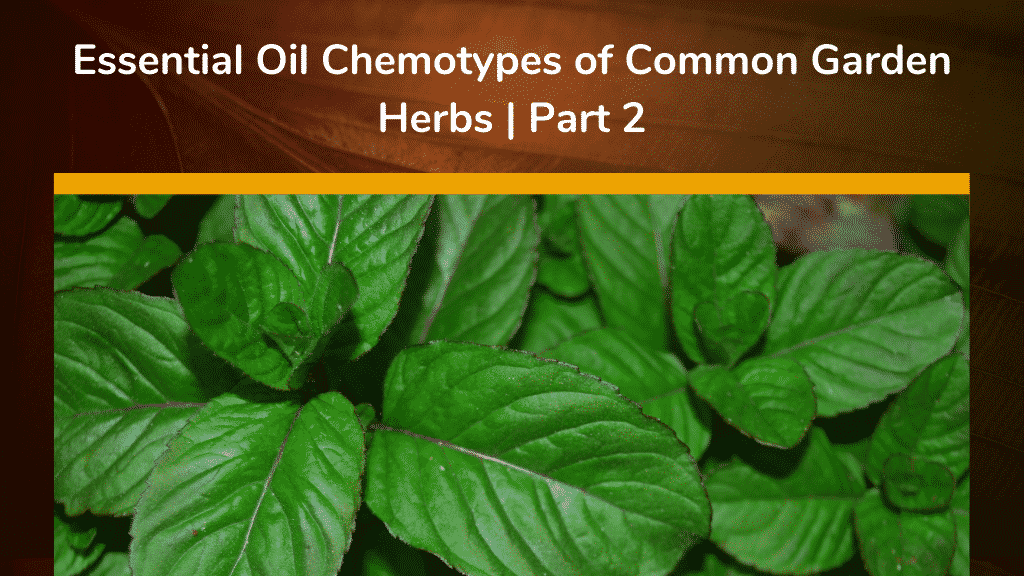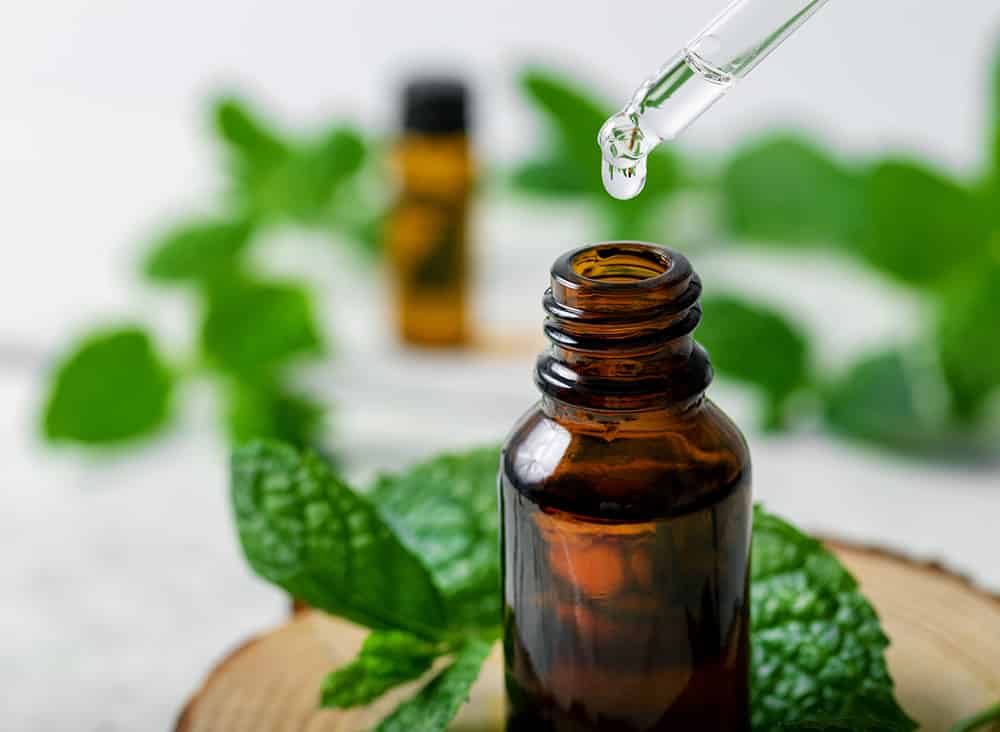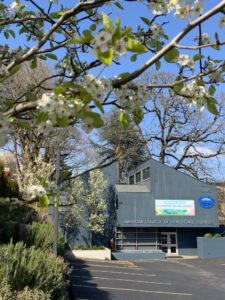
By Kathy Sadowski, MS in Aromatherapy, RA, LMT
This article originally appeared in the NAHA Journal (Spring 2021) and it is republished here according to the NAHA Writer Guidelines 2021 copyright statement.
In Part 1, Kathy discussed what to look for in a plant’s name and some key chemical differences between basil (Ocimum basilicum), Roman chamomile (Chamaemelum nobile), and lavender (Lavandula angustifolia).
In this blog post, Kathy will explain key chemical differences between sweet marjoram (Origanum majorana), mint (Mentha spp.), oregano (Origanum vulgare), sage (Salvia spp.), and thyme (Thymus vulgaris).
If you haven’t read Part 1 yet, take a look to learn more about botanical names and chemotypes before reading further.
Sweet Marjoram (Origanum majorana)

There are numerous chemotypes of sweet marjoram (Origanum majorana). To make it more confusing, some plants may have the common name of marjoram, like Spanish marjoram (Thymus mastichina), but are not in the same genus.
Spanish marjoram (Thymus mastichina) essential oil is high in the constituents of 1,8-cineole, camphor, alpha-pinene, camphene, and borneol.[3] This species has a camphoraceous aroma that may aid in breathing. However, the 1,8-cineole and camphor content should be avoided with young children and certain medical conditions.[3]
Sweet marjoram (Origanum majorana) essential oil is high in the constituents of Terpinen-4-ol, sabinene hydrate, linalyl acetate, and gamma-terpinene. This is a delightful chemotype with a spicy-woody fresh scent. There are no known safety considerations.[3]
Wild marjoram (Origanum majorana ct. carvacrol) essential oil can have over 76% carvacrol content, while the linalool chemotype has over 67% linalool.[3]
- The carvacrol chemotype will smell like oregano, because of its high carvacrol content. This chemotype is a possible dermal and mucus membrane irritant. Also, avoid the essential oil and too much of the herb with children, pregnant and breastfeeding women, and certain medical conditions due to the carvacrol.[11]
- The linalool chemotype has a floral note, but still contains up to 23% carvacrol content, reminiscent of oregano.[3]
Sweet marjoram herb is a favorite in cooking and its light herbaceous flavor can be best enjoyed when not over-cooked. Add a few leaves of fresh basil to a dish during the last few minutes of cooking.
Safety: As an herb, avoid ingesting sweet marjoram beyond normal food quantities during pregnancy, lactation, with small children, or for prolonged periods of time.[7] Some chemical varieties of sweet marjoram most similar to oregano could be contraindicated with certain medical conditions beyond normal food spice amounts.[14]
Mint (Mentha spp.)

Plants of the Mentha genus have almost twenty-four unique species, with countless hybridizations and variations. Here are the most common species used to make essential oils:
- Corn mint (Mentha arvensis) is often dementholized for aromatherapy use, and the essential oil contains the key constituents of menthol, menthone, isomenthone, and limonene.[9]
- Peppermint (Mentha × piperita) is a hybrid of water mint (Mentha aquatica) and spearmint (Mentha spicata). The essential oil is comprised primarily of the components of menthol, menthone, isomenthone, and 1,8-cineole.[9]
- Spearmint (Mentha spicata) essential oil contains high amounts of carvone and limonene constituents.[9]
Benefits: These three mint plants may be helpful with respiratory and digestive complaints. Those containing menthol (corn mint (Mentha arvenis) and peppermint (Mentha × piperita) may also offer topical analgesic activity.[12]
Safety: The menthol and carvacrol constituents found in corn mint and peppermint essential oils can be a skin and mucus membrane irritant. In excess, the menthone and pulegone constituents can be toxic.[3] Avoid use of these two essential oils with pregnancy, young children, and certain medical conditions.
The high carvone content of spearmint can be an irritant for the skin and mucous membrane and has a maximum dermal use level of 1.7%.[3]
Use of the herb leaves of corn mint, peppermint, and spearmint are generally safe in small food quantity amounts. However, avoid eating peppermint or corn mint leaves and drinking the tea with gallstones. [7]
Oregano (Origanum spp.)

In the Origanum genus, there are over fifty species, plus many varieties. Popular oregano species used to extract for essential oils include common oregano (Origanum vulgare), Greek oregano (Origanum onites), and true Greek oregano (Origanum vulgare subsp. hirtum). All three essential oils are high in carvacrol content with p-cymene, gamma-terpinene, and thymol as additional key constituents.[3] In the culinary world, these types of oreganos are described as Mediterranean oregano.
Plants commonly called Mexican oregano are not technically a member of the Origanum family and include Lippia graveolens. Much higher in thymol content, with p-cymene, carvacrol, and 1,8-cineole as additional key constituents, Mexican oregano offers a more intense flavor well suited for Southwestern cuisine.[13]
Plants high in the constituents of carvacrol and thymol (like oregano and some types of thyme) demonstrate significant antimicrobial activities but can be toxic in excess.
Safety: Avoid use of oregano essential oils with young children, pregnant and breastfeeding women, and those with certain medical conditions. These essential oils may also be sensitizing to the skin and mucus membrane.[9]
As an herb used in small amounts, oregano is generally well tolerated. Avoid in doses beyond normal food spice amounts with pregnancy, small children, and certain medical conditions.[14]
Sage (Salvia spp.)

Salvia is the largest genus in the Lamiaceae family, with over 500 species found growing in America.15 Even our dear friend rosemary moved over to the Salvia family recently, with her new name becoming Salvia rosmarinus.
Common sage (Salvia officinalis) essential oil is high in the constituents of camphor and alpha-thujone, two highly potent and toxic constituents when used in excess. Thus, this species has multiple contraindications for use in aromatherapy. Other varieties of sage seen in essential oils include Greek sage (S. fruticose), white sage (S. apiana), and Spanish sage (S. lavandulifolia), which are all high in 1,8-cineole content and also contain camphor, which may help with respiratory complaints.
As an herb, avoid use beyond normal food spice amounts with children, pregnant women, and certain medical conditions. Some people have an allergy or hypersensitivity to sage species and should avoid internal and topical use. Also, avoid use with asthma. [14]
| Sage Smudge Sticks
Sage is a staple garden herb used in cooking, and its leaves contain 1-2.5% essential oil.[7] However, my favorite thing to do with the sage growing in my garden is to make smudge sticks. Roll up the dried leaves with twine. Carefully light an end and let the smoke smudge away bad energy in a building or home! |
Thyme (Thymus spp.)

With over 350 plants in the Thymus genus, there is also huge array of chemical variations. Even within the Thymus vulgaris species, there are multiple chemotypes:
Thymus vulgaris ct. carvacrol is high in carvacrol content.[3]
- Benefits: This plant type is similar to oregano in flavor and aroma, with significant antimicrobial activity.
- Safety: The essential oil is a possible skin and mucus membrane irritant. Also, avoid the use of the essential oil with young children, pregnant and breastfeeding women, and those with certain medical conditions.[9]
Thymus vulgaris ct. thymol is high in thymol content.[3][9]
- Benefits: The plant’s flavor and aroma are less intense than oregano and offer antimicrobial activities.
- Safety: The essential oil can be skin and mucus membrane sensitizing. Avoid using essential oils high in thymol and/or carvacrol content with young children, pregnant and breastfeeding women, and those with certain medical conditions.[9]
Thymus vulgaris ct. geraniol can contain over 60% geranyl acetate and geraniol content.[3]
- Benefits: This plant has a relaxing floral aroma.
- Safety: This essential oil chemotype is gentle. There may be possible drug interactions related to the geraniol constituent.[3]
Thymus vulgaris ct. limonene can contain 28% thymol, 24% limonene, and 21% carvacrol content.[3]
- Benefits: This plant may offer antimicrobial activity with a slight lemon note.
- Safety: The essential oil can be skin and mucus membrane sensitizing. Avoid using essential oils high in thymol and/or carvacrol content with young children, pregnant and breastfeeding women, and those with certain medical conditions.[9]
Thymus vulgaris ct. linalool can contain constituents of 79% linalool, and up to 7% linalyl acetate.[3]
- Benefits: This plant smells floral and gentle.
- Safety: There are no known safety concerns.
Other Thymus species used in aromatherapy include Moroccan thyme (T. satureioides) which is high in borneol, carvacrol, beta terpineol, and thymol content. Lemon thyme (T. citriodorus) is high in geraniol, carvacrol, geranial, and neral constituents. And these three species are high in thymol and carvacrol: spike thyme (T. spicata), white thyme (T. zygis), and wild thyme (T. serpyllum).[3]
Conclusion: In summary, within a plant family, genus, and even species, there can be significant chemo-variations that affect aroma, taste, and therapeutic use. When purchasing essential oils, it is a good idea to choose a supplier that offers GC-MS testing results that identify key chemical constituents. If you are growing herbs at home for cooking or making teas and health recipes, knowing the plants scientific name can be helpful, but organoleptic testing may also assist in determining different chemotypes.
Recipe

Thyme for a Breather Tea
Ingredients
- 24-oz. boiled water
- 1 Tbsp. fresh organically grown peppermint (Mentha × piperita) leaves, finely cut
- ½ tsp. fresh organically grown thyme (Thymus vulgaris) leaves, minced
- 1 Tbsp. honey
To Make: Pour boiled water over herbs and steep for nine minutes. Strain. Add honey to taste.
To Use: Adults should not exceed drinking three cups a day.
Cautions: Avoid consuming peppermint with gallbladder health issues, including gallstones.[7] May be contraindicated for use with certain medical conditions and medications.
References
[1] Bowles, J. (2003). The Chemistry of Aromatherapeutic Oils. 3rd Allen & Unwin.
[2] Buckle, J. (2003). Clinical Aromatherapy Essential Oils in Practice. 2nd Churchill Livingstone.
[3] Tisserand, R. & Young, R. (2014). Essential Oil Safety, 2nd Edition. Churchill Livingstone, Elsevier.
[4] Sadowski, K. (2019). Methyl chavicol / Estragole / p-allyanisole / Isoanethole. Retrieved on 3/3/2021. Retrieved from https://www.earthtokathy.com/
methyl-chavicol-estragole-
p-allyanisole-isoanethole/
[5] Clarke, S. (2009). Essential Chemistry for Aromatherapy. Elsevier Health Sciences.
[6] Sadowski, K. (2020). Eugenol. Retrieved on 3/3/21. Retrieved from: https://www.earthtokathy.com/
eugenol/
[7] Witchl, M. (2004). Herbal Drugs and Phytopharmaceutical: A Handbook for Practice on a Scientific Basis. Third Edition. MedPharm Scientific Publishers.
[8] Sadowski, K. (2019). What is the Difference Between German Chamomile and Roman Chamomile? Retrieved on 3/3/2021. Retrieved from: https://www.uhrohmuh.com/
2019/10/31/what-is-the-difference-
between-german-chamomile-
and-roman-chamomile/
[9] Lis-Balchin, M. (2006). Aromatherapy Science: A Guide for Healthcare Professionals. Pharmaceutical Press.
[10] Sadowski, K. (2020). Lavender (Lavandula angustifolia) Research. Retrieved on 3/3/2021. Retrieved from: https://www.earthtokathy.com/
lavender-lavandula
-angustifolium-research/
[11] Sadowski, K. (2019). Retrieved on 3/3/2020. Retrieved from: https://www.earthtokathy.com/
carvacrol/
[12] Sadowski, K. (2020). Retrieved on 3/3/2020. Retrieved from: https://www.earthtokathy.com/
menthol/
[13] Spices Inc. (n.d.). Oregano Throwdown. Mediterranean Oregano vs Mexican Oregano. Retrieved on 3/3/2021. Retrieved from: https://www.spicesinc.com/
p-3778-th
e-oregano-throwdown-
mediterranean-vs-mexican.aspx
[14] Ulbricht, C. (2010). Natural Standard. Herb & Supplement Guide: An Evidence Based Reference.
[15] Elpel, T. (2018). Botany in a Day: The Patterns Method of Plant Identification. An Herbal Field Guide to Plant Families of North America. US: Hops Press.
About Kathy Sadoswki:
Kathy Sadowski has a Master of Science degree in Aromatherapy from the American College of Healthcare Sciences. With a passion for reading scientific studies on herbs and essential oils, she has developed the website www.EarthtoKathy.com, which categorizes 4,000 plus scientific research articles on plants by species, therapeutic action, and constituent. The goal is to demonstrate a growing amount of evidence for the potential healthful uses of herbs and essential oils. Kathy is a professional member of NAHA and AIA, a Registered Aromatherapist (ARC), licensed massage therapist, and enthusiast for environmental protection and a natural lifestyle. Visit Kathy’s website at: www.EarthtoKathy.com
Disclaimer: This article is for informational purposes only. It is not intended to treat, diagnose, cure, or prevent disease. This article has not been reviewed by the FDA. Always consult with your primary care physician or naturopathic doctor before making any significant changes to your health and wellness routine.
About American College of Healthcare Sciences
 American College founded in 1978, is a fully online accredited institute of higher education specializing in holistic health. Based in Portland, OR; our goal is to make research-driven and science-based holistic health education taught by industry-leading experts accessible to anyone anywhere while still giving students a hands-on experiential learning experience like a traditional college and a strong sense of community, school pride and student bond.
American College founded in 1978, is a fully online accredited institute of higher education specializing in holistic health. Based in Portland, OR; our goal is to make research-driven and science-based holistic health education taught by industry-leading experts accessible to anyone anywhere while still giving students a hands-on experiential learning experience like a traditional college and a strong sense of community, school pride and student bond.
This commitment to our students and graduates reflects in our current survey results that reflect 98% of our students would recommend ACHS to a friend or family member.
We believe education is the most powerful tool for changing an individual and the world around us.
When a person enrolls as ACHS, it is vitally important that they graduate with tools they need to forge their own holistic and sustainable missions, build up their communities confidently and changing the face of healthcare with knowledge.
 President’s Message: End Of Year Reflectionsby American College of Healthcare Sciences●December 31, 2020
President’s Message: End Of Year Reflectionsby American College of Healthcare Sciences●December 31, 2020 Student Highlight: Wife and Husband Team Start New Businessby American College of Healthcare Sciences●December 22, 2020
Student Highlight: Wife and Husband Team Start New Businessby American College of Healthcare Sciences●December 22, 2020 Student Highlight: Holistic Health, Gratitude, and Smoothies |achs.eduby American College of Healthcare Sciences●December 17, 2020
Student Highlight: Holistic Health, Gratitude, and Smoothies |achs.eduby American College of Healthcare Sciences●December 17, 2020 3 Tips For Building Better Habitsby American College of Healthcare Sciences●December 10, 2020
3 Tips For Building Better Habitsby American College of Healthcare Sciences●December 10, 2020
